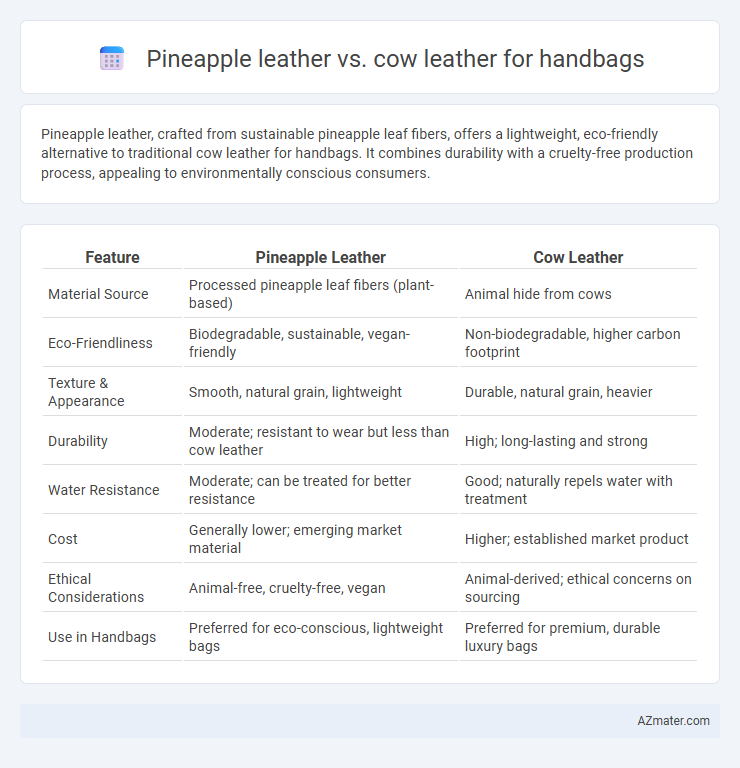Pineapple leather, crafted from sustainable pineapple leaf fibers, offers a lightweight, eco-friendly alternative to traditional cow leather for handbags. It combines durability with a cruelty-free production process, appealing to environmentally conscious consumers.
Table of Comparison
| Feature | Pineapple Leather | Cow Leather |
|---|---|---|
| Material Source | Processed pineapple leaf fibers (plant-based) | Animal hide from cows |
| Eco-Friendliness | Biodegradable, sustainable, vegan-friendly | Non-biodegradable, higher carbon footprint |
| Texture & Appearance | Smooth, natural grain, lightweight | Durable, natural grain, heavier |
| Durability | Moderate; resistant to wear but less than cow leather | High; long-lasting and strong |
| Water Resistance | Moderate; can be treated for better resistance | Good; naturally repels water with treatment |
| Cost | Generally lower; emerging market material | Higher; established market product |
| Ethical Considerations | Animal-free, cruelty-free, vegan | Animal-derived; ethical concerns on sourcing |
| Use in Handbags | Preferred for eco-conscious, lightweight bags | Preferred for premium, durable luxury bags |
Introduction to Pineapple Leather and Cow Leather
Pineapple leather, also known as Pinatex, is an innovative sustainable material made from pineapple leaf fibers, offering a cruelty-free and eco-friendly alternative to traditional leather. Cow leather, derived from cattle hides, is a durable and widely used material known for its strength, natural texture, and longevity in handbag production. Comparing pineapple leather and cow leather highlights differences in environmental impact, texture, and maintenance requirements crucial for handbag consumers seeking sustainable fashion options.
Environmental Impact: Pineapple vs Cow Leather
Pineapple leather, also known as Pinatex, significantly reduces environmental impact by utilizing pineapple leaf fibers, a renewable agricultural waste product, thus avoiding deforestation and excessive water consumption associated with cow leather production. Traditional cow leather involves high greenhouse gas emissions, intensive water use, and chemical tanning processes that contribute to pollution and health hazards. Choosing pineapple leather for handbags supports sustainable practices by lowering carbon footprint and minimizing harmful environmental effects compared to conventional animal-based leather.
Material Sourcing and Sustainability
Pineapple leather, derived from pineapple leaf fibers, offers a sustainable alternative to traditional cow leather by utilizing agricultural waste that would otherwise be discarded, reducing environmental impact. Cow leather production involves resource-intensive processes, including water usage, land degradation, and greenhouse gas emissions from cattle farming. The renewable and biodegradable nature of pineapple leather enhances eco-friendly sourcing, making it a favorable choice for environmentally conscious handbag manufacturing.
Durability and Longevity Comparison
Pineapple leather, made from the fibers of pineapple leaves, offers impressive resistance to wear and tear but generally falls short of the durability exhibited by traditional cow leather, which is known for its strength and ability to develop a patina over time. Cow leather's dense fiber matrix provides superior abrasion resistance and longevity, often lasting decades with proper care, while pineapple leather is more prone to surface damage and may degrade faster under heavy use. Innovations in pineapple leather treatments are enhancing its durability, making it a viable sustainable alternative, though cow leather remains the benchmark for long-term handbag durability.
Aesthetic Appeal and Design Versatility
Pineapple leather offers a unique textured surface with a slightly matte finish, providing handbags an eco-friendly, modern aesthetic that appeals to sustainable fashion enthusiasts. Cow leather delivers classic smoothness and rich grain patterns, allowing for a luxurious and timeless design versatile across formal and casual styles. The adaptability of pineapple leather in vibrant colors contrasts with cow leather's natural patina, influencing handbag design from bold and innovative to elegant and traditional.
Comfort and Texture Differences
Pineapple leather, derived from natural fibers, offers a lightweight and breathable alternative to cow leather, enhancing comfort during prolonged use. Its texture is smoother and more pliable, with a subtle grain that feels soft against the skin compared to the denser and firmer surface of cow leather. Cow leather provides a robust, durable texture ideal for structured handbags, while pineapple leather delivers a flexible, eco-friendly option with a unique tactile experience.
Manufacturing Processes
Pineapple leather, derived from the fiber of pineapple leaves, undergoes a sustainable manufacturing process involving natural extraction, drying, and binding with non-toxic polyurethane, resulting in an eco-friendly alternative to traditional leather. Cow leather production requires animal husbandry, slaughter, and complex tanning processes often involving chromium salts and chemicals to enhance durability and appearance. The contrast in environmental impact and resource consumption between pineapple leather and cow leather defines their respective manufacturing processes, with pineapple leather emphasizing renewable inputs and minimal chemical use.
Cost Analysis: Pineapple Leather vs Cow Leather
Pineapple leather typically costs 20-40% more than cow leather due to its sustainable production methods and lower mass production scale. Cow leather benefits from an established supply chain and economies of scale, resulting in more affordable prices for handbags. The higher price of pineapple leather reflects its eco-friendly appeal and innovative material processing, which can increase initial investment but offer long-term value in sustainable fashion markets.
Ethical Considerations for Consumers
Pineapple leather, made from sustainable pineapple leaf fibers, offers an eco-friendly alternative to traditional cow leather by reducing animal cruelty and lowering environmental impact through less water and chemical usage. Consumers seeking ethical handbags prioritize pineapple leather for its biodegradable properties and renewable sourcing, aligning with cruelty-free and vegan values. Cow leather production involves significant carbon emissions, deforestation, and ethical concerns over livestock treatment, making pineapple leather a preferable choice for ethical consumers.
Future Trends in Handbag Materials
Pineapple leather, derived from sustainable Pinatex fibers, is rapidly gaining popularity as an eco-friendly alternative to traditional cow leather in handbag manufacturing. Innovations in plant-based leathers like pineapple and mushroom leather are expected to dominate future handbag materials due to reduced environmental impact and enhanced biodegradability. Market projections indicate a continuous rise in consumer demand for cruelty-free, vegan leather options, positioning pineapple leather as a key material in sustainable fashion trends.

Infographic: Pineapple leather vs Cow leather for Handbag
 azmater.com
azmater.com